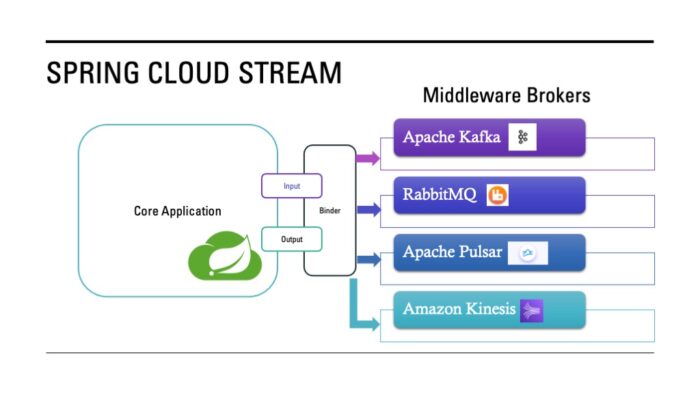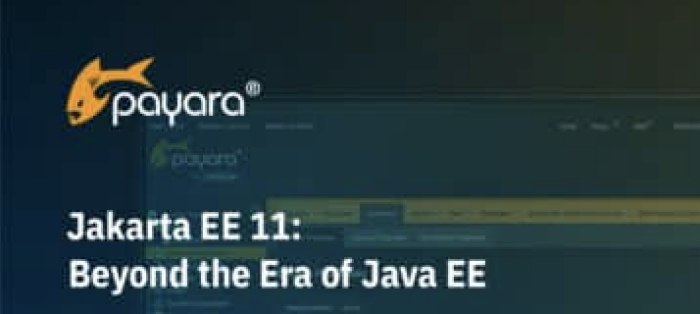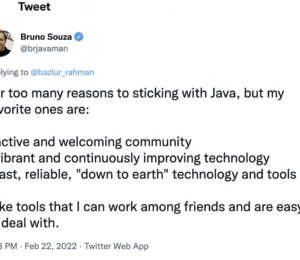Spring Cloud Stream: Event-Driven Architecture – Part 1
- July 21, 2025
- 5192 Unique Views
- 4 min read
Envision operating a successful e-commerce platform where every moment is crucial. Customers make purchases, adjust inventory levels, process payments, and dispatch shipping alerts—all in real time. In the background, microservices diligently function to guarantee seamless operations. However, how do these services interact effectively, particularly during peak traffic occurrences such as flash sales or holiday shopping events?
An efficient method to execute this use case involves utilizing Spring Cloud Stream (SCS) as the messaging infrastructure. SCS facilitates seamless interaction among microservices, enhancing the system's responsiveness and scalability. A significant benefit of SCS is that it provides an abstraction layer, allowing developers to transition between messaging technologies such as Kafka or RabbitMQ or Pulsar or Amazon Kinesis without altering their fundamental business logic.
You can choose the technology based on the specific use case and customer requirements, whether you prioritize the reliability of RabbitMQ, the scalability of Apache Kafka, the flexibility of Apache Pulsar, or the cloud-native capabilities of Amazon Kinesis. Spring Cloud Stream offers a cohesive programming model that allows you to work with all of these options.

A wide array of message brokers and binder implementations available in the market is offered by Spring Cloud Stream, with each possessing its own unique strengths.
The Role of MessageBrokers
Messaging brokers simplify the complexities of event-driven systems:
- Address distributed computing fallacies.
- Provide guarantees based on the CAP theorem (Consistency, Availability, Partitioning).
- Offer client APIs to interact with them for building event-driven and stream-processing applications.
Frameworks or Binder Implementations
To simplify complexity, frameworks conceal the low-level specifics and provide user-friendly APIs for developers. Examples include:
- RabbitMQ:
- Provides excellent lightweight and dependable messaging, supporting intricate routing patterns.
- Uses AMQP (Advanced Message Queuing Protocol).
- Framework: Spring for AMQP simplifies integration for Spring-based applications.
- Apache Kafka:
- Handles high-throughput, distributed event streaming and enables real-time data analysis.
- Offers low-level client libraries like the Java client.
- Frameworks such as Spring for Apache Kafka make it easier for Spring developers to work with Kafka.
- Apache Pulsar:
- Offers an outstanding option for multi-tenancy, geo-replication, and large-scale event streaming.
Offers built-in support for pub-sub messaging and stream processing.
Framework: Spring for Apache Pulsar streamlines development.
- Offers an outstanding option for multi-tenancy, geo-replication, and large-scale event streaming.
- Amazon Kinesis:
- Facilitates serverless, cloud-native streaming with extensive AWS integration.
Developers have the opportunity to utilize abstractions and frameworks, which allows them to concentrate on constructing business logic without needing to worry about the intricate details of messaging systems. Nevertheless, they face a degree of risk when they employ frameworks that closely integrate with the application code. If you change messaging platforms, you must rewrite and recompile your code. This situation makes applications less portable and more challenging to maintain.
Spring Cloud Stream: The Solution
Developers can use Spring Cloud Stream to create sophisticated abstractions for event-driven applications, removing their reliance on particular messaging brokers.
Key Features:
Consistent Programming Model:
- Operates effortlessly across various messaging platforms (e.g., Kafka, RabbitMQ, Pulsar).
- The identical application code can be utilized irrespective of the underlying message broker.
Loose Coupling:
- Facilitates independent microservices that interact through the broker without tightly binding their implementations.
Supports Application Types:
- Producer: Sends events to the message broker.
- Consumer: Receives events from the message broker.
- Processor: Both receives and sends events.
Handles Low-Level Details:
- Automatically manages communication and coordination with the broker.
Benefits of Spring Cloud Stream
- Simplifies event-driven microservice development.
- Focus on business needs, not messaging code.
- Inherits all advantages of Spring Boot:
- Autoconfiguration.
- Simplified dependency management.
- Production-ready features (e.g., metrics, health checks).
To incorporate Spring Cloud Stream into your current Spring Boot application, you must identify the appropriate release train cadence based on the version of Spring Boot you are utilizing. For more details you can refer to the link under Adding Spring Cloud To An Existing Spring Boot Application section
LightWeight Architecture with Spring Cloud Stream
In the Spring Cloud Stream methodology, the framework actively manages the message broker communication activities for both producer and consumer applications. This management results in a more straightforward and uniform architecture.
Transition to Spring Cloud Stream:
If you have experience in developing Spring Boot applications, you will find that incorporating Spring Cloud Stream is quite simple. You just need to add two more dependencies:
1. Spring Cloud Stream Core Module:
- Dependency: spring-cloud-stream
- Provides the core functionality of Spring Cloud Stream.
2. Broker-Specific Binder:
- Examples:
- spring-cloud-stream-binder-kafka (for Kafka)
- spring-cloud-stream-binder-rabbit (for RabbitMQ)
- spring-cloud-stream-binder-pulsar (for Apache Pulsar)
3. Spring Cloud Stream Data Dictionary
- Binder: A component in Spring Cloud Stream that connects your application to the messaging system. Abstracts away low-level connection and communication details. And implementation of messaging middleware like Kafka or RabbitMQ or Apache Pulsar or Amazon Kinesis
- Binding: A developer designed a set of Java functions to process, transform, or transmit messages.
- Channel: The messaging middleware connects to the application through the communication channel.
- Message Schemas: These schemas can either be statically read from a specified location or loaded dynamically for the serialization and deserialization of messages, thereby supporting the evolution of domain object types.
- Stream Listeners: Beans automatically trigger methods for handling messages upon receiving a message from the channel, following the MessageConverter's serialization/deserialization process between middleware-specific events and domain object types or POJOs.
In the forthcoming article, we will explore the main functions utilized in Spring Cloud Stream and demonstrate how to integrate with binder implementations using RabbitMQ, Kafka, Apache Pulsar, or Amazon Kinesis through an example.
Conclusion
Spring Cloud Stream offers a sophisticated, flexible, and scalable approach to building event-driven systems, which eliminates the challenges associated with direct broker integration.
References
https://spring.io/projects/spring-cloud
https://spring.io/projects/spring-cloud-stream
Don’t Forget to Share This Post!








Comments (0)
No comments yet. Be the first.